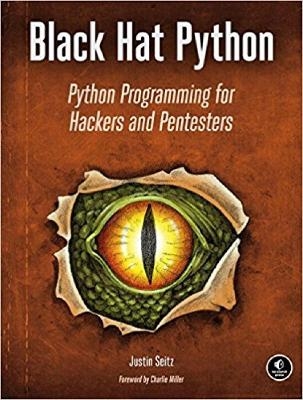
Black Hat Python
Seiten
2014
No Starch Press,US (Verlag)
978-1-59327-590-7 (ISBN)
No Starch Press,US (Verlag)
978-1-59327-590-7 (ISBN)
- Titel z.Zt. nicht lieferbar
- Versandkostenfrei innerhalb Deutschlands
- Auch auf Rechnung
- Verfügbarkeit in der Filiale vor Ort prüfen
- Artikel merken
When it comes to creating powerful and effective hacking tools, Python is the language of choice for most security analysts. But just how does the magic happen?
In Black Hat Python, the latest from Justin Seitz (author of the best-selling Gray Hat Python), you’ll explore the darker side of Python’s capabilities—writing network sniffers, manipulating packets, infecting virtual machines, creating stealthy trojans, and more. You’ll learn how to:
- Create a trojan command-and-control using GitHub
- Detect sandboxing and automate common malware tasks, like keylogging and screenshotting
- Escalate Windows privileges with creative process control
- Use offensive memory forensics tricks to retrieve password hashes and inject shellcode into a virtual machine
- Extend the popular Burp Suite web-hacking tool
- Abuse Windows COM automation to perform a man-in-the-browser attack
- Exfiltrate data from a network most sneakily
Insider techniques and creative challenges throughout show you how to extend the hacks and how to write your own exploits.
When it comes to offensive security, your ability to create powerful tools on the fly is indispensable. Learn how in Black Hat Python.
Uses Python 2
In Black Hat Python, the latest from Justin Seitz (author of the best-selling Gray Hat Python), you’ll explore the darker side of Python’s capabilities—writing network sniffers, manipulating packets, infecting virtual machines, creating stealthy trojans, and more. You’ll learn how to:
- Create a trojan command-and-control using GitHub
- Detect sandboxing and automate common malware tasks, like keylogging and screenshotting
- Escalate Windows privileges with creative process control
- Use offensive memory forensics tricks to retrieve password hashes and inject shellcode into a virtual machine
- Extend the popular Burp Suite web-hacking tool
- Abuse Windows COM automation to perform a man-in-the-browser attack
- Exfiltrate data from a network most sneakily
Insider techniques and creative challenges throughout show you how to extend the hacks and how to write your own exploits.
When it comes to offensive security, your ability to create powerful tools on the fly is indispensable. Learn how in Black Hat Python.
Uses Python 2
Justin Seitz is a senior security researcher for Immunity, Inc., where he spends his time bug hunting, reverse engineering, writing exploits, and coding Python. He is the author of Gray Hat Python (No Starch Press), the first book to cover Python for security analysis.
Introduction
Chapter 1: Setting Up Your Python Environment
Chapter 2: The Network: Basics
Chapter 3: The Network: Raw Sockets and Sniffing
Chapter 4: Owning the Network with Scapy
Chapter 5: Web Hackery
Chapter 6: Extending Burp Proxy
Chapter 7: GitHub Command and Control
Chapter 8: Common Trojaning Tasks on Windows
Chapter 9: Fun With Internet Explorer
Chapter 10: Windows Privilege Escalation
Chapter 11: Automating Offensive Forensics
Index
| Erscheint lt. Verlag | 21.12.2014 |
|---|---|
| Verlagsort | San Francisco |
| Sprache | englisch |
| Maße | 178 x 234 mm |
| Themenwelt | Informatik ► Netzwerke ► Sicherheit / Firewall |
| Informatik ► Programmiersprachen / -werkzeuge ► Python | |
| Mathematik / Informatik ► Informatik ► Theorie / Studium | |
| Mathematik / Informatik ► Informatik ► Web / Internet | |
| ISBN-10 | 1-59327-590-0 / 1593275900 |
| ISBN-13 | 978-1-59327-590-7 / 9781593275907 |
| Zustand | Neuware |
| Haben Sie eine Frage zum Produkt? |
Mehr entdecken
aus dem Bereich
aus dem Bereich
Buch | Hardcover (2012)
Westermann Schulbuchverlag
34,95 €
Schulbuch Klassen 7/8 (G9)
Buch | Hardcover (2015)
Klett (Verlag)
30,50 €
Buch | Softcover (2004)
Cornelsen Verlag
25,25 €


